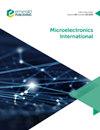回流温度和焊料尺寸对Cu/Sn/Ni微焊点Cu-Ni相互作用的影响
IF 0.8
4区 工程技术
Q4 ENGINEERING, ELECTRICAL & ELECTRONIC
引用次数: 1
摘要
用于芯片互连的旧凸点从目前的约100 μ m缩小到未来的1 μ m。因此,Cu/Solder/Ni焊点中的Cu-Ni相互作用将更加复杂,从而强烈影响金属间化合物(IMCs)的生长。因此,了解微焊点界面反应的基本方面是至关重要的。本文旨在揭示回流温度和焊料尺寸对Cu/ solder /Ni焊点界面反应的影响机理。设计/方法/方法分别在250°C和300°C下观察了50和100 μ m尺寸的Cu/Sn/Ni微焊点中的Cu-Ni相互作用。将线型互连线浸泡在硅油中,采用精密k型热电偶监测线型互连线温度为250±3℃和300±3℃,并在不同时间进行等温老化过程。老化后,将样品从硅油中取出,在空气中冷却至室温。结果两个界面上的主要反应产物均为(Cu,Ni)6Sn5,且(Cu,Ni)6Sn5 IMCs在Sn/Ni界面处的厚度总是大于Sn/Cu界面处的IMCs,表明(Cu,Ni)6Sn5的不对称生长是由于Cu原子在Cu浓度梯度下向Sn/Ni界面方向迁移所致。250℃时Sn/Cu界面处(Cu,Ni)6Sn5 IMC形貌为柱状,300℃时由柱状变为大纵横比的扇贝;250℃时Sn/Ni界面处(Cu,Ni) IMC形貌由针状逐渐演变为针状和层状混合,300℃时由针状演变为大纵横比的扇贝。(Cu,Ni)6Sn5的形貌演变与Ni含量有关。此外,结果表明,在Cu/Sn/Ni微焊点中,当焊料尺寸较小、温度较低时,Cu-Ni相互作用更强。(Cu,Ni)6Sn5在Cu/Sn/Ni微焊点中的不对称生长,从Sn/Ni界面处(Cu,Ni)6Sn5 IMCs的厚度可以看出,IMCs的厚度总是大于Sn/Cu界面处的IMCs。(Cu,Ni)6Sn5 IMC在两个界面的形貌演变归因于Ni的含量。在Cu/Sn/Ni微焊点中,钎料尺寸越小、温度越低,Cu-Ni相互作用越强。本文章由计算机程序翻译,如有差异,请以英文原文为准。
Effect of reflow temperature and solder size on Cu-Ni cross-interaction in the Cu/Sn/Ni micro solder joints
Purpose
Solder bumps for chip interconnections are downsizing from current approximately 100 µm to the expected 1 µm in future. As a result, the Cu-Ni cross-interaction in Cu/Solder/Ni solder joints will be more complicated and then strongly influence the growth of the intermetallic compounds (IMCs). Thus, it is critical to understand the fundamental aspects of interfacial reaction in micro solder joints. This paper aims to reveal the effect mechanism of reflow temperature and solder size on the interfacial reaction in Cu/Solder/Ni solder joints.
Design/methodology/approach
The Cu-Ni cross-interaction in the Cu/Sn/Ni micro solder joints with 50 and 100 µm solder sizes at 250°C and 300°C were observed, respectively. The line-type interconnects were soaked in silicone oil, and the temperature of the line-type interconnects was 250 ± 3°C and 300 ± 3°C, which were monitored by a fine K-type thermocouple, and followed by an isothermal aging process at various times. After aging, the specimens were removed from the silicone oil and cooled in the air to room temperature.
Findings
The major interfacial reaction product on both interfaces was (Cu,Ni)6Sn5, and the asymmetric growth of (Cu,Ni)6Sn5, evidenced by the thickness of (Cu,Ni)6Sn5 IMCs at the Sn/Ni interface was always larger than that at the Sn/Cu interface, resulted from the directional migration of Cu atoms toward the Sn/Ni interface under Cu concentration gradient. The morphology of (Cu,Ni)6Sn5 IMC at Sn/Cu interface was columnlike at 250°C, and which changed from columnlike to scallop with large aspect ratio at 300°C, while that at Sn/Ni interface gradually evolved from needlelike to the mixture of needlelike and layered at 250°C, and which evolved from needlelike to scallop with large aspect ratio at 300°C. The evolution of morphology of (Cu,Ni)6Sn5 is attributed to the content of Ni. Furthermore, the results indicate that the Cu-Ni cross-interaction was stronger with small solder size and relatively low temperature in the Cu/Sn/Ni micro solder joints.
Originality/value
The asymmetric growth of (Cu,Ni)6Sn5 in the Cu/Sn/Ni micro solder joints, evidenced by the thickness of (Cu,Ni)6Sn5 IMCs at the Sn/Ni interface, was always larger than that at the Sn/Cu interface. The morphology evolution of (Cu,Ni)6Sn5 IMC at both interfaces was attributed to the content of Ni. The Cu-Ni cross-interaction was stronger with small solder size and relatively low temperature in the Cu/Sn/Ni micro solder joints.
求助全文
通过发布文献求助,成功后即可免费获取论文全文。
去求助
来源期刊

Microelectronics International
工程技术-材料科学:综合
CiteScore
1.90
自引率
9.10%
发文量
28
审稿时长
>12 weeks
期刊介绍:
Microelectronics International provides an authoritative, international and independent forum for the critical evaluation and dissemination of research and development, applications, processes and current practices relating to advanced packaging, micro-circuit engineering, interconnection, semiconductor technology and systems engineering. It represents a current, comprehensive and practical information tool. The Editor, Dr John Atkinson, welcomes contributions to the journal including technical papers, research papers, case studies and review papers for publication. Please view the Author Guidelines for further details.
Microelectronics International comprises a multi-disciplinary study of the key technologies and related issues associated with the design, manufacture, assembly and various applications of miniaturized electronic devices and advanced packages. Among the broad range of topics covered are:
• Advanced packaging
• Ceramics
• Chip attachment
• Chip on board (COB)
• Chip scale packaging
• Flexible substrates
• MEMS
• Micro-circuit technology
• Microelectronic materials
• Multichip modules (MCMs)
• Organic/polymer electronics
• Printed electronics
• Semiconductor technology
• Solid state sensors
• Thermal management
• Thick/thin film technology
• Wafer scale processing.
 求助内容:
求助内容: 应助结果提醒方式:
应助结果提醒方式:


